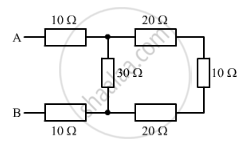Advertisements
Advertisements
प्रश्न

उत्तर
The resistors of values 20 Ω, 10 Ω and 20 Ω are connected in series. Therefore, their net resistance is:
R = 20 Ω + 10 Ω + 20 Ω
R = 50 Ω
This combination of resistors are connected in parallel with that of value 30 Ω. Therefore, the resistance R' is:
1/R' = (1/50) + (1/30)
1/R' = (3 + 5)/150
R' = 150/8
R' = 18.75 Ω
The resistance, R' is connected in series with the two resistors of values 10 Ω each. Hence, the total resistance between A and B is:
18.75 + 10 + 10 = 38.75 Ω
APPEARS IN
संबंधित प्रश्न
A battery of 9 V is connected in series with resistors of 0.2 Ω, 0.3 Ω, 0.4 Ω, 0.5 Ω and 12 Ω, respectively. How much current would flow through the 12 Ω resistor?
When a 4 Ω resistor is connected across the terminals of a 12 V battery, the number of coulombs passing through the resistor per second is:
(a) 0.3
(b) 3
(c) 4
(d) 12
If five resistances, each of value 0.2 ohm, are connected in series, what will be the resultant resistance?
You are supplied with a number of 100 Ω resistors. How could you combine some of these resistors to make a 250 Ω resistor?
Choose the correct alternative and rewrite the following sentence.
If three resistors 2 ohms, 3 ohms and 4 ohms are connected in series, then the effective resistance in the circuit will be _______ ohms.
A given metallic wire of resistance R is doubled on itself. What will be its new resistance?
How does the resistivity of a semiconductor depend on temperature?
If R1 and R2 be the resistance of the filament of 40 W and 60 W respectively operating 220 V, then:
If the current I through a resistor is increased by 100% (assume that temperature remains unchanged), the increase in power dissipated will be:
